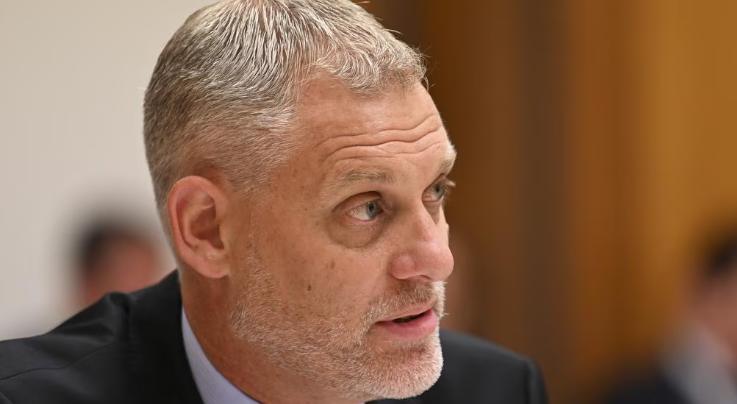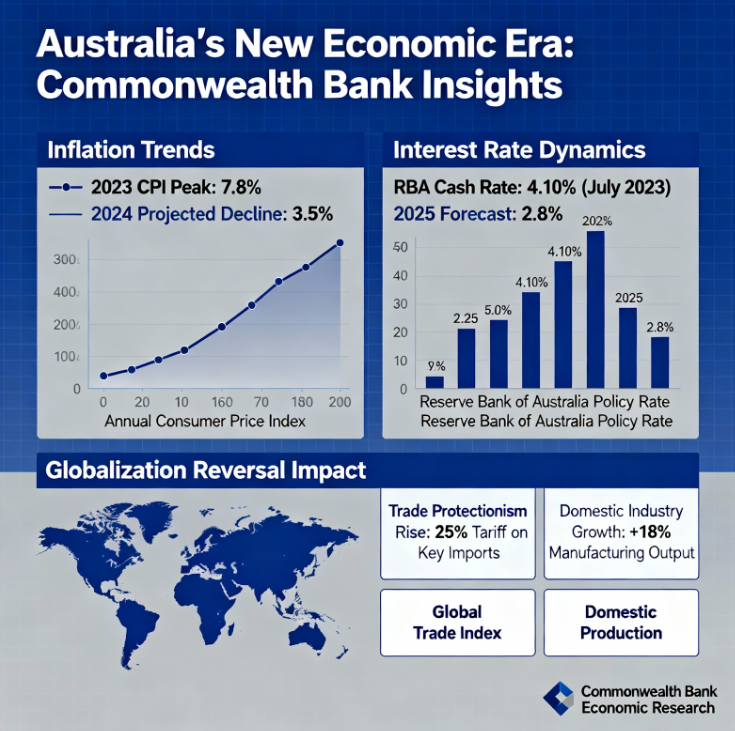The Commonwealth Bank of Australia has declared the beginning of a new economic era. The bank’s chief economist, Luke Yeaman, stated that this period marks a fundamental shift from previous decades. He said, “We have transitioned into a new economic era, characterised by rules that significantly differ from those of the past.”

The Commonwealth Bank of Australia declared a new economic era
Economic Security Over Efficiency
According to Yeaman, global priorities now favour economic security rather than economic efficiency. This transition comes amid rising geopolitical tension, trade barriers, and government interventions across major economies. He emphasised that “economic security now takes precedence over economic efficiency.”
The CBA report, titled Fasten Your Seatbelt: Making Sense of a New Economic Era, explained that nations are turning inward. This shift has caused an increase in government involvement and a decline in global productivity.

Globalisation in Reverse
The bank noted that globalisation has entered reverse gear. Countries are imposing more trade and investment restrictions while tightening regulatory controls. These measures, CBA warned, could reduce overall economic efficiency. The report stated that policies focused on national resilience, including supply chain security, will increase costs across industries.
Rise in Policy Uncertainty
CBA economists highlighted a surge in policy uncertainty, particularly in trade and manufacturing sectors. Yeaman warned investors that markets might underestimate prolonged disruptions. He said that geopolitics will drive economic outcomes more than traditional market forces.
He also said, “This is a long-term struggle for strategic dominance; it is not solely about immediate economic concerns.”
Impact on Interest Rates
The report suggested that the new environment would place long-term upward pressure on interest rates. The neutral rate, also known as R*, could rise as governments spend more to secure domestic industries. Increased investment in defence, energy, and technology is likely to strain public budgets.
In Australia, the Reserve Bank’s key interest rate currently sits at 3.6 percent after its August rate cut. However, CBA now expects any further rate reductions to be limited, with a potential final cut in early 2026 if inflation continues to ease.

Commonwealth Bank insights
Inflation and Economic Risks
The Australian Bureau of Statistics reported inflation at 2.1 percent in the second quarter, nearing the RBA’s 2–3 percent target range. While this supports the RBA’s cautious stance, a growing number of economists expect persistent inflationary pressure.
Recent data showed a renewed rise in consumer prices, driven by energy costs and global supply constraints. CBA analysts noted that these forces could offset the effects of monetary easing. The report cautioned that inflation fluctuations could influence policy decisions into 2026.
Australia’s Strategic Dilemma
Australia faces a strategic dilemma as it balances economic ties with China and security ties with the United States. Economist Richard Denniss of the Australia Institute said that trade policy discussions in Australia still follow outdated assumptions. He explained that while the nation once enjoyed prosperity from China and security from the US, the current environment demands a new approach.
Denniss added, “There was never truly a free trade era. There was a period of freer trade… but that has come to an end.”
He said Australians must prepare for an economic environment dominated by political and security considerations rather than market forces.
Market and Industry Implications
CBA predicted a future of divided markets, growing intervention, and higher volatility. These shifts could weaken productivity growth across developed economies. Industries reliant on global supply chains, including manufacturing and technology, face increased vulnerability to disruptions.
The report said, “This new era will bring sustained higher levels of economic and market volatility, increased domestic investment, structural strains on government budgets, and heightened government involvement in the economy.”
According to the analysis, critical mineral sectors, renewable energy, and defence manufacturing could experience the strongest demand growth. However, higher investment in these sectors will likely sustain inflationary pressure and lift borrowing costs.
A Harder Road Ahead
CBA analysts described the current environment as one of competing priorities. Governments are now intervening more frequently to protect economic interests. Yeaman said that these transformations are “detrimental to global growth and productivity, reversing some of the advancements made during the globalisation period.”
The report said global productivity growth is slowing as efficiency gives way to resilience-focused policies. Increased regulation across Western economies is another factor reducing economic flexibility.
A Shift in Global Power
The rise of protectionism and state-driven investment reflects a larger power struggle between the United States and China. Yeaman explained that this contest for global dominance will persist beyond immediate trade disputes.
He warned investors not to underestimate the duration of this transformation. CBA considers this geopolitical economic realignment a structural shift that will define the coming decades.
The Role of Investment and Savings
CBA’s research projected that long-term structural changes would lift overall investment levels. This shift will affect the balance between savings and investment, contributing to higher neutral interest rates.
Yeaman noted that this adjustment marks a reversal from recent decades of low rates driven by global surplus savings. Governments will also compete for capital as public spending rises across key sectors.
Also Read: Picasso’s 1943 Dora Maar Portrait Reignites Market Momentum With €32 Million Paris Sale
Australia’s Economic Resilience
CBA recognised Australia’s resilience thanks to its trade diversity and resource base. Chief Executive Officer Matt Comyn earlier said that the country remains well-positioned to navigate growing trade tensions. However, the bank acknowledged that slowing growth among key trading partners and greater regulation could limit the country’s momentum.
Australia’s economy grew by 1.3 percent over the past year, below the forecast of 1.5 percent. The weaker growth reflects lower exports and declining consumption despite stable employment levels.
Preparing for the Future
CBA urged policymakers and businesses to adapt to the evolving environment. Strategic planning, regional cooperation, and focus on long-term productivity will be essential. The report advised investors to consider diversified assets as market volatility increases.
Denniss stressed that domestic policy should prioritise stability and cooperation rather than rivalry. He urged voters to support policies that reinforce ties with reliable trade partners.
Concluding Outlook
CBA’s warning suggests an enduring transformation in global economics. The period of open markets and global efficiency has given way to one prioritising security and control.
As Yeaman summarised, “We have transitioned into a new economic era.”
For Australia, this means higher interest rates, persistent policy intervention, and an altered relationship between markets and governments. In this new order, both investors and policymakers must navigate the era of uncertainty with discipline and foresight.











